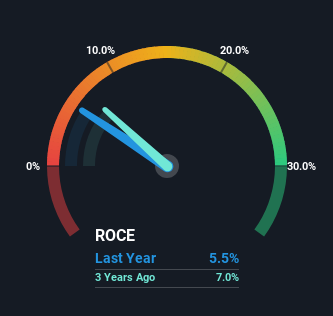- Brazil
- /
- Consumer Durables
- /
- BOVESPA:UCAS3
We Like These Underlying Return On Capital Trends At Unicasa Indústria de Móveis (BVMF:UCAS3)
If we want to find a stock that could multiply over the long term, what are the underlying trends we should look for? Amongst other things, we'll want to see two things; firstly, a growing return on capital employed (ROCE) and secondly, an expansion in the company's amount of capital employed. Ultimately, this demonstrates that it's a business that is reinvesting profits at increasing rates of return. Speaking of which, we noticed some great changes in Unicasa Indústria de Móveis' (BVMF:UCAS3) returns on capital, so let's have a look.
What Is Return On Capital Employed (ROCE)?
For those that aren't sure what ROCE is, it measures the amount of pre-tax profits a company can generate from the capital employed in its business. To calculate this metric for Unicasa Indústria de Móveis, this is the formula:
Return on Capital Employed = Earnings Before Interest and Tax (EBIT) ÷ (Total Assets - Current Liabilities)
0.055 = R$12m ÷ (R$299m - R$89m) (Based on the trailing twelve months to June 2023).
Therefore, Unicasa Indústria de Móveis has an ROCE of 5.5%. Ultimately, that's a low return and it under-performs the Consumer Durables industry average of 7.7%.
Check out our latest analysis for Unicasa Indústria de Móveis

Historical performance is a great place to start when researching a stock so above you can see the gauge for Unicasa Indústria de Móveis' ROCE against it's prior returns. If you want to delve into the historical earnings, revenue and cash flow of Unicasa Indústria de Móveis, check out these free graphs here.
So How Is Unicasa Indústria de Móveis' ROCE Trending?
Unicasa Indústria de Móveis has broken into the black (profitability) and we're sure it's a sight for sore eyes. While the business was unprofitable in the past, it's now turned things around and is earning 5.5% on its capital. Interestingly, the capital employed by the business has remained relatively flat, so these higher returns are either from prior investments paying off or increased efficiencies. That being said, while an increase in efficiency is no doubt appealing, it'd be helpful to know if the company does have any investment plans going forward. Because in the end, a business can only get so efficient.
For the record though, there was a noticeable increase in the company's current liabilities over the period, so we would attribute some of the ROCE growth to that. Effectively this means that suppliers or short-term creditors are now funding 30% of the business, which is more than it was five years ago. It's worth keeping an eye on this because as the percentage of current liabilities to total assets increases, some aspects of risk also increase.
The Key Takeaway
As discussed above, Unicasa Indústria de Móveis appears to be getting more proficient at generating returns since capital employed has remained flat but earnings (before interest and tax) are up. Considering the stock has delivered 38% to its stockholders over the last five years, it may be fair to think that investors aren't fully aware of the promising trends yet. Given that, we'd look further into this stock in case it has more traits that could make it multiply in the long term.
On a separate note, we've found 3 warning signs for Unicasa Indústria de Móveis you'll probably want to know about.
While Unicasa Indústria de Móveis may not currently earn the highest returns, we've compiled a list of companies that currently earn more than 25% return on equity. Check out this free list here.
New: AI Stock Screener & Alerts
Our new AI Stock Screener scans the market every day to uncover opportunities.
• Dividend Powerhouses (3%+ Yield)
• Undervalued Small Caps with Insider Buying
• High growth Tech and AI Companies
Or build your own from over 50 metrics.
Have feedback on this article? Concerned about the content? Get in touch with us directly. Alternatively, email editorial-team (at) simplywallst.com.
This article by Simply Wall St is general in nature. We provide commentary based on historical data and analyst forecasts only using an unbiased methodology and our articles are not intended to be financial advice. It does not constitute a recommendation to buy or sell any stock, and does not take account of your objectives, or your financial situation. We aim to bring you long-term focused analysis driven by fundamental data. Note that our analysis may not factor in the latest price-sensitive company announcements or qualitative material. Simply Wall St has no position in any stocks mentioned.
About BOVESPA:UCAS3
Unicasa Indústria de Móveis
Unicasa Indústria de Móveis S.A. manufacture, sell, import, and export furniture in Brazil.
Second-rate dividend payer with low risk.
Market Insights
Community Narratives



